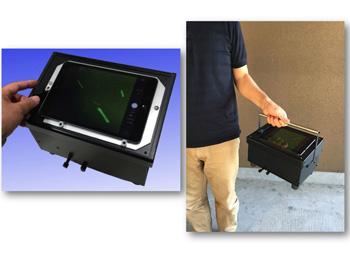【Key features】
・Portable Fluorescence Microscope for iPad enables on-site detection of asbestos
・With iPad connectivity, users can receive real-time advice and testing assistance from a remote asbestos laboratory
A Portable Fluorescence Microscope for iPad has been developed by Hiroshima University spin-off venture Siliconbio Inc. in cooperation with Opto Science Inc., and using basic technology from Hiroshima University’s Integrated Research Center for Smart Biosensing. In addition to on-site testing, the microscope can help novice users receive expert advice and testing assistance from a remote asbestos laboratory.

Fig. 1 Portable Fluorescence Microscope for iPad
Using blue LEDs as a source of excitation light, the microscope integrates objective and eyepiece lenses, excitation/emission filters and dichroic mirror with an iPad camera. The microscope resolution is
The Portable Fluorescence Microscope for iPad will be exhibited at the 55th Annual Meeting of the Japan Occupational Hygiene Association in Hakodate (October 21-23, 2015). It will also be introduced at the symposium “New emerging biosensing technology in water, atmosphere, and soil environment: Heading towards implementation,” hosted by the Society for Biotechnology, Japan on October 26-28.
The Portable Fluorescence Microscope for iPad will be released in January 2016 by Siliconbio Inc. An explanation video is available at the following website:
http://siliconbio.co.jp
【Background】
It has been more than 10 years since the “asbestos shock” brought to light the full extent of asbestos contamination in Japan, yet many people are still suffering from asbestos-related diseases. Even now, there are reports of asbestos fiber releases during renovation or demolition of old buildings and facilities. To prevent human exposure to asbestos, there is a need for a rapid, on-site method to detect airborne asbestos fibers.
Hiroshima University researchers have recently developed a novel asbestos detection method that relies on fluorescently stained asbestos-binding proteins, making an important contribution in the field of asbestos testing. However, since fluorescence microscopes are developed with no regard for portability, in general they cannot be used for on-site testing in the field.
To make the full use of the new asbestos detection method, Hiroshima University researchers sought to re-design the optical path of fluorescence microscope.
【Related newsReference】
1Asbestos contamination found near building demolition site (in Japanese)
2Asbestos release during construction work at subway station (in Japanese)
3Development of highly sensitive asbestos detection method for rapid on-site testing (in Japanese)
【Contact】
Akio Kuroda
Professor, Graduate School for Advanced Sciences of Matter, Hiroshima University
Leader, Integrated Research Center for Smart Biosensing
Tel:+81-(0)82-424-7758 Fax:+81-(0)82-424-7047
E-mail:akuroda*hiroshima-u.ac.jp
(Please change * to @)
(※)iPad is the registered trademark of Apple Inc.

 Home
Home














